Ground Anchor
A prestressed grouted ground anchor is a structural element installed in soil or rock that is used to transmit an applied tensile load into the ground. Grouted ground anchors, referenced simply as ground anchors, are installed in grout filled drill holes. Grouted ground anchors are also referred to as “tiebacks”. The basic components of a grouted ground anchor include the:
- anchorage;
- free stressing (unbonded) length;
- bond length.
These and other components of a ground anchor are shown schematically in figure 1. The anchorage is the combined system of anchor head, bearing plate, and trumpet that is capable of transmitting the prestressing force from the prestressing steel (bar or strand) to the ground surface or the supported structure.
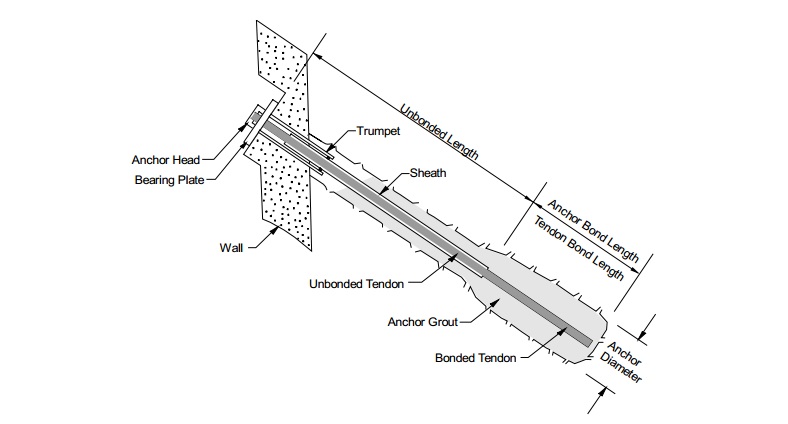
Figure 1. Components of a ground anchor.
Anchorage components for a bar tendon and a strand tendon are shown in figure 2 and figure 3, respectively. The unbonded length is that portion of the prestressing steel that is free to elongate elastically and transfer the resisting force from the bond length to the structure. A bondbreaker is a smooth plastic sleeve that is placed over the tendon in the unbonded length to prevent the prestressing steel from bonding to the surrounding grout. It enables the prestressing steel in the unbonded length to elongate without obstruction during testing and stressing and leaves the prestressing steel unbonded after lock-off. The tendon bond length is that length of the prestressing steel that is bonded to the grout and is capable of transmitting the applied tensile load into the ground. The anchor bond length should be located behind the critical failure surface.
A portion of the complete ground anchor assembly is referred to as the tendon. The tendon includes the prestressing steel element (strands or bars), corrosion protection, sheaths (also referred to as sheathings), centralizers, and spacers, but specifically excludes the grout. The definition of a tendon, as described in PTI (1996), also includes the anchorage; however, it is assumed herein that the tendon does not include the anchorage. The sheath is a smooth or corrugated pipe or tube that protects the prestressing steel in the unbonded length from corrosion. Centralizers position the tendon in the drill hole such that the specified minimum grout cover is achieved around the tendon. For multiple element tendons, spacers are used to separate the strands or bars of the tendons so that each element is adequately bonded to the anchor grout. The grout is a Portland cement based
mixture that provides load transfer from the tendon to the ground and provides corrosion protection for the tendon.
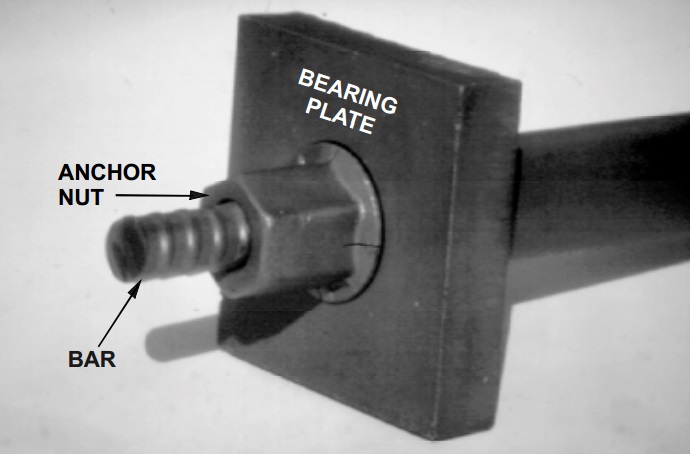
Figure 2. Anchorage components for a bar tendon.
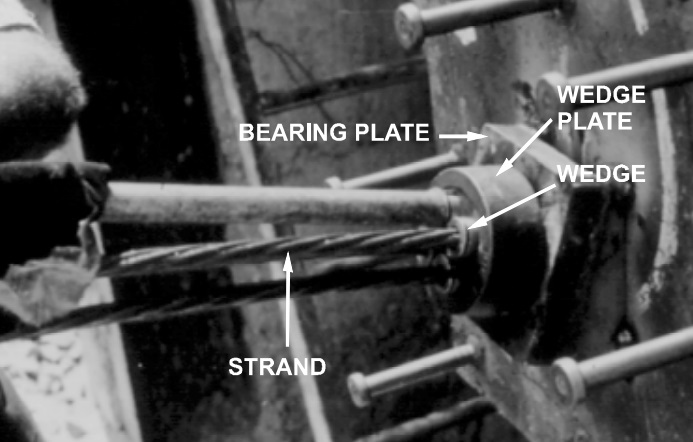
Figure 3. Anchorage components for a strand tendon.
Applications
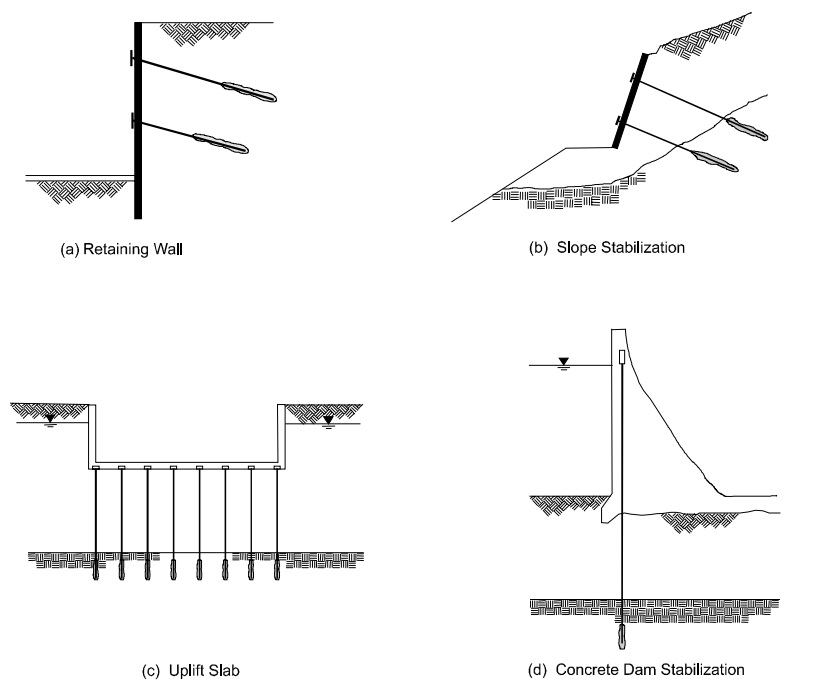
Types of Ground Anchors
A- Straight shaft gravity-grouted ground anchors
Straight shaft gravity-grouted ground anchors are typically installed in rock and very stiff to hard cohesive soil deposits using either rotary drilling or hollow-stem auger methods. Tremie (gravity displacement) methods are used to grout the anchor in a straight shaft borehole.
B- Straight shaft pressure-grouted ground anchors
Straight shaft pressure-grouted ground anchors are most suitable for coarse granular soils and weak fissured rock. This anchor type is also used in fine grained cohesionless soils. With this type of anchor, grout is injected into the bond zone under pressures greater than 0.35 MPa.
C- Post-grouted ground anchors
Post-grouted ground anchors use delayed multiple grout injections to enlarge the grout body of straight shafted gravity grouted ground anchors.
D- Underreamed anchors
Underreamed anchors consist of tremie grouted boreholes that include a series of enlargement bells or underreams. This type of anchor may be used in firm to hard cohesive deposits.
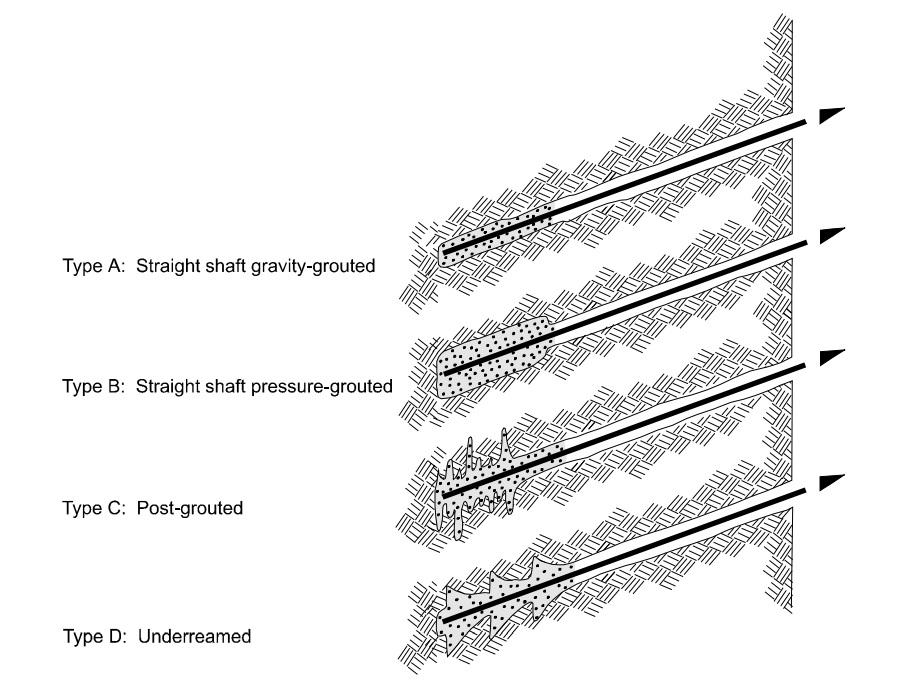
Anchor Load Testing
A unique aspect of ground anchors, as compared to other structural systems, is that every ground anchor that is to be part of a completed structure is load tested to verify its load capacity and load-deformation behavior before being put into service. The acceptance or rejection of ground anchors is determined based on the results of:
1- Performance tests;
Performance tests involve incremental loading and unloading of a production anchor. The performance test is used to verify anchor capacity, establish load-deformation behavior, identify causes of anchor movement, and to verify that the actual unbonded length is equal to or greater than that assumed in the anchor design.
2- Proof tests;
The proof test involves a single load cycle and a load hold at the test load. The magnitude of the applied load is measured using the jack pressure gauge.
3- Extended creep tests.
An extended creep test is a long duration test (e.g., approximately 8 hours) that is used to evaluate creep deformations of anchors.
The results of these tests are compared to specified acceptance criteria to evaluate whether the ground anchor can be put into service. The acceptance criteria are based on allowable creep and elastic movements of the anchor during load testing.
Advantages
- Execute excavations neatly to create large construction plan without using props in order to make mechanized excavation.
- Keep excavation walls sustainable, make very deep excavations without depending on the basement structure.
- Anchors combine with soft retaining walls to redistribute the intemal forces of wall structure, so this can reduce the size, depth of steel bars in retaining walls.
Disadvantages
- It is necessary to use specifed equipment, exprienced professional engineers.
- It is difficult to apply anchors in weak soil and to implement anchors with great depth.
- Anchor execution would affect the land of surrounding construction works, which must be accepted by their owners.
Sources; Federal Highway Administration – Ground Anchors and Anchored Systems, xmt.vn
Videos;
